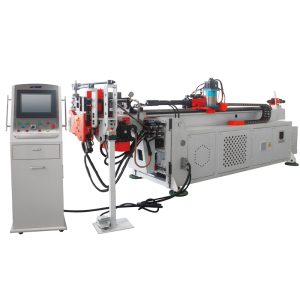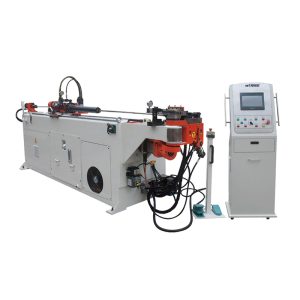One-stop Bending Solutions For Wires, Tubes And Pipes
One-stop Bending Solutions For Wires, Tubes And Pipes
In the current wave of rapid development in the industrial field, the application scenarios of metal pipes are becoming increasingly extensive. From aerospace, automobile manufacturing to construction engineering, medical equipment and many other industries, the demand for metal pipes has shown explosive growth. More importantly, the requirements for the shapes of metal pipes are becoming more and more complex and diverse. Ordinary pipe bending machines, which once occupied an important position in industrial production, are gradually becoming unable to cope with the current demand for high-precision and complex-shaped metal pipe processing. Their processing accuracy, efficiency and adaptability to complex processes are difficult to meet the stringent standards of modern industrial production. It is in this market context that fully automatic pipe bending machines came into being. Through continuous system design optimization and technological development, they have become the core equipment in the field of pipe processing, completely changing the pattern of traditional pipe bending processing.

I. Core Differences Between Fully Automatic and Conventional Pipe Benders
(1) Bending Radius and Control Precision
Fully automatic pipe bending machines demonstrate exceptional performance in controlling bending radius. Conventional models can easily achieve a bending radius of 1.5 times the pipe diameter. Specifically developed models, tailored to the processing needs of specialized industries, can even achieve an extremely small bending radius of 1.0 times the pipe diameter—a nearly insurmountable gap for conventional pipe benders. Regarding core motion control, the three key axes of a fully automatic pipe bender—bending, feeding, and rotating—are all controlled by high-precision servo motors. The servo motors’ precise drive characteristics ensure the stability and consistency of each movement.
In contrast, while some conventional pipe bender models are equipped with touchscreen controls, their core clamp design utilizes a direct clamping mechanism. This structure is not only prone to interference with the pipe or other components during processing, but more importantly, the bending precision is significantly lower than that of fully automatic pipe benders. In terms of specific precision parameters, the fully automatic tube bending machine can precisely control the feed length accuracy to ±0.1mm, and the tube rotation and bending angle accuracy can both reach ±0.1 degrees. This level of accuracy meets the requirements of most high-precision processing scenarios. Conventional tube bending machines, however, due to limitations in their control methods and mechanical structure, often only have feed length errors of ±1mm or more, and angle errors are generally ±1 degree or higher. In industries with stringent precision requirements, such as automotive engine piping and aerospace duct processing, products produced by conventional tube bending machines are prone to dimensional deviations and fail to meet assembly requirements.
(2) Operational Convenience and Troubleshooting
Fully automatic pipe bending machines are designed with user experience in mind. They utilize an LCD touchscreen with a menu-based interface. The interface is simple and intuitive, allowing even first-time operators to quickly master basic operating procedures. The program setting process is straightforward and easy to understand, requiring no complex professional knowledge. More importantly, the fully automatic pipe bending machine is equipped with a comprehensive detection and error message display system. During operation, if an operational error or mechanical failure occurs, the system immediately detects the abnormal signal and clearly displays the error type, location, and corresponding troubleshooting suggestions on the touchscreen. Operators can quickly identify and address the problem based on these prompts, significantly reducing equipment downtime and improving production efficiency.
While conventional pipe bending machines possess certain operational functions, they clearly lack operational convenience and troubleshooting capabilities. Some conventional pipe bending machines have cumbersome user interfaces, and program settings require the operator to manually adjust multiple mechanical knobs or parameters. This is not only time-consuming and labor-intensive, but also prone to processing errors due to human error. Moreover, the fault detection system of ordinary pipe bending machines is often not perfect. When the equipment fails, it can usually only be judged based on the operator’s experience. The troubleshooting process is complicated and time-consuming, and sometimes even requires professional maintenance personnel to be on site to solve the problem, which seriously affects the production progress.
(3) Energy Saving and Processing Quality Assurance
In terms of energy conservation, fully automatic pipe bending machines utilize a plunger-type oil pump, which boasts high energy conversion efficiency and can precisely adjust the oil pressure output according to processing requirements. This avoids unnecessary energy loss associated with traditional oil pumps during operation, effectively saving energy consumption. It also provides stable oil pressure for the equipment, ensuring process stability.
Fully automatic pipe bending machines offer unique advantages for bending thin tubes or those with small bend radii (1.0D to 1.5D CLR). Equipped with a slow core extraction function, they enable a slow and steady core extraction process, effectively avoiding deformation and wrinkling of thin tubes caused by excessively fast core extraction speeds, thus ensuring high-quality processing. Conventional pipe bending machines, lacking this special function, are prone to severe deformation and poor appearance when processing thin tubes or those with small bend radii, making them unable to meet high-quality processing requirements.

Ⅱ. The reasons why fully automatic pipe bending machines are favored by the pipe processing industry
In the pipe processing process, poor angles, inaccurate dimensions, and cosmetic defects are three major challenges that have long plagued the industry. These problems not only affect product assembly precision and performance, but also increase production costs and reduce efficiency. The emergence of fully automatic pipe bending machines, with their advanced technology and superior performance, has successfully addressed these challenges, becoming the preferred equipment for the pipe processing industry.
Fully automatic pipe bending machines utilize CNC technology in close collaboration with computers, enabling precise, real-time control of mechanical components. During the processing process, the computer sends instructions to each actuator through the CNC system based on preset processing parameters, ensuring that each processing action is carried out strictly according to the preset requirements, thereby ensuring consistent bending angles and precise dimensional accuracy. Whether used in mass production or customized processing, fully automatic pipe bending machines maintain stable processing quality and effectively avoid processing errors caused by human factors.
At the same time, the fully automatic pipe bending machine also has a complete quality assurance system, which can monitor the processing parameters and pipe status in real time during the processing. Once an abnormal situation is detected, the system will immediately issue an alarm and suspend processing. Production will continue only after the problem is resolved, fundamentally eliminating the production of unqualified products.

III. Core Features and Advantages of Fully Automatic Pipe Bending Machines
(I) Advanced Control and Operation System
1. Programmable Controller Control: The fully automatic pipe bending machine utilizes a high-performance programmable controller (PLC) as its core control system. The PLC boasts powerful logical operations and data processing capabilities, enabling complex control logic to meet the requirements of diverse processing techniques. Furthermore, the PLC’s exceptional stability and reliability ensure long-term stable operation in harsh industrial environments, ensuring continuous production.
2. Convenient Program Modification and Parameter Setting: Operators can easily modify processing formulas and related parameters via the touchscreen to meet specific processing requirements, eliminating the need for complex mechanical adjustments. Furthermore, the machine’s simple and intuitive parameter setting process, coupled with a Chinese-language input interface, lowers the operational barrier, allowing even operators with limited education to quickly master the process, significantly improving operational efficiency.
3.Efficient Process Control: The fully automatic pipe bending machine’s processing operations, including bending, rotating, loading and unloading, are all controlled by servo motors equipped with speed positioning capabilities. The servo motors precisely adjust the operating speed according to processing requirements, enabling rapid positioning and stable processing. This not only increases processing speed but also ensures precision. Its repeatability can reach plus or minus 0.1 degrees, ensuring highly consistent processing accuracy for each product in mass production.
(II) Comprehensive Safety and Troubleshooting Mechanisms
1. Programmed Automatic Detection System: To prevent equipment damage or processing accidents caused by human error, the fully automatic pipe bending machine is equipped with a programmed automatic detection system. This system comprehensively checks the processing program, parameter settings, and equipment status before operation. If any operational error or equipment anomaly is detected, it immediately disables the machine and issues an alarm, ensuring the safety of both operators and equipment.
2. Detailed Error Information Display and Troubleshooting Guide: When a malfunction occurs, the system automatically records the fault information and clearly displays the error type, fault code, possible cause, and troubleshooting instructions on the touchscreen. These prompts allow operators to quickly locate the fault and perform repairs, significantly reducing troubleshooting time and improving equipment utilization.
(III) Diverse Functional Adaptability and Expansion Capabilities
1. Springback Measurement: Due to the varying physical properties of pipes from different batches and materials, springback is prone to occur after bending, affecting processing accuracy. Fully automatic pipe bending machines are equipped with a springback measurement function that accurately measures the springback characteristics of each batch of pipes. Based on the measurement results, they automatically adjust processing parameters to compensate for the springback, ensuring that the final processing accuracy meets the required standards.
2. Reciprocating Feeding: Conventional pipe bending machines often fall short of meeting the requirements for processing extremely long pipes due to their limited feeding length. However, fully automatic pipe bending machines feature a reciprocating feeding function. Through multiple reciprocating feeds, they can process pipes of unlimited length, greatly expanding the machine’s processing range and meeting the needs of various industries for processing extremely long pipes.
3. Flexible Operating Mode Switching: Fully automatic pipe bending machines can flexibly switch between different operating modes to meet the processing needs of different types and specifications of pipes. The operator only needs to make simple settings on the touch screen, and the equipment can automatically adjust the processing parameters and action flow to adapt to different processing tasks. There is no need to replace the equipment or make complex mechanical adjustments, which improves the versatility and flexibility of the equipment.

IV. High-Quality Service and Customized Solutions from a Professional Manufacturer
When choosing a fully automatic pipe bender, it’s crucial to select a manufacturer with extensive industry experience and strong capabilities. As a leading domestic manufacturer of fully automatic pipe benders, our company leverages years of expertise in pipe processing equipment, accumulating extensive experience in R&D, production, and service. We are able to provide customers with high-quality, high-performance fully automatic pipe bender products.
Our product range includes a wide range of fully automatic pipe bender types, capable of processing a wide variety of pipe materials, including stainless steel, copper, aluminum, and steel. These products meet the processing needs of various industries, including automotive, aerospace, medical device, furniture, and pipeline engineering. We also understand that processing requirements vary from customer to customer, and therefore offer professional, customized services.
During the customization process, our professional technical team will conduct in-depth consultations with customers to fully understand their product specifications, material properties, production scale, and process requirements. Based on the customer’s specific needs, our technical team will conduct solution design, simulation testing, and optimization adjustments to ensure that the customized fully automatic pipe bender perfectly fits the customer’s production process and meets their individual processing needs.
If you are looking for a high-quality fully automatic pipe bending machine or have customized processing requirements, please feel free to contact us. We will provide strong support for your pipe processing business with a professional attitude, high-quality products and comprehensive services, and work together to create a better future!
Our equipment has CE, ISO quality inspection certificate, so the quality is guaranteed to be cost-effective. According to different processing requirements, machines can be customized to fit for your usage, to provide customized services. In the processing period, we strictly control the production process, to ensure the quality of clearance, standardize the process, strict implementation.
